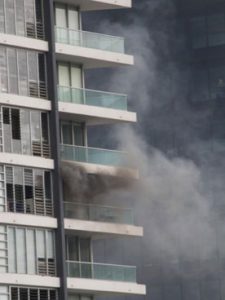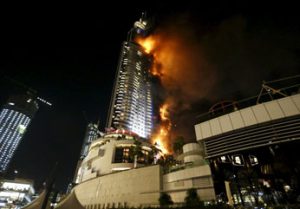The Grenfell Tower fire of June 14 and the role of Composite Sandwich Panel Cladding
Sadly the risks identified in our Briefing Note 315 (April 2016), and which you can again read below, have been realised in London in the June 14 Grenfell Tower fire with the loss of at least 80 lives. The building had smoke detectors but no automatic sprinklers and only a single central staircase for access and evacuation.
Immediately after the fire it was clear that the cladding material had amplified the fire risk. It’s claimed that in a recent refurbishment of the building, a bid seeking to employ higher quality (less combustible) cladding was rejected on cost considerations.
Fire services had earlier reinforced the message to residents that in the case of a fire in someone else’s apartment they were to stay in their home until told otherwise. This advice was on the presumption that a fire could be contained to a single apartment, which was clearly not the case as the cladding led to a fire engulfing the entire building.
The government has taken immediate steps to conduct an audit of hi-rise (>18 m) social housing across the country to see just how widespread the problem is and to ensure that any other similar risks be identified and acted upon. It has also set up an expert panel to advise on other urgent steps to improve fire safety.
Housing associations, local authorities and private landlords are currently engaged in a checking and testing process for Aluminium Composite Material (ACM) cladding at the Building Research Establishment. The Department for Communities and Local Government has extended this checking and testing approach to residential tower blocks owned by private landlords and to tall buildings in the public sector, including hospitals and schools.
The current screening programme only tests the filler. We do not yet know the number of buildings involved, but by the end of Thursday June 29, none of the cladding materials tested satisfied the limited combustibility required by the building regulation guidance.
Building standard requirements set out a requirement that external walls on all buildings do not allow fire spread. Each individual element of the wall — insulation, filler material, etc. — must be of limited combustibility, and each component must meet set standards for this. The second requirement is that the combined elements of a wall, when tested as a whole system, have sufficient fire spread resistance to satisfy the set standard. This was clearly not the case for the Grenfell Tower, or any of the other buildings described in the Briefing note below.
The challenge moving forward is two-fold:
- Ensuring that the use of combustible cladding is limited on new buildings, and1. Ensuring that the use of combustible cladding is limited on new buildings, and
- Addressing the significant risk in the current building stock arising from the use of combustible cladding.
Removing cladding from high-rise buildings will present its own set of risks and costs and may not be the best strategy. Authorities and building owners need to accept that a significant risk exists and then to analyse this to aid decision-making. What is needed is an overall assessment of risk to those living in such buildings. This is not just a fire engineering problem, but a risk problem, and one that also poses a significant issue for the insurance industry.
This is a challenge for many countries, not just the UK and Australia.
More information on the UK Government’s building safety program can be found at:
Role of Composite Sandwich Panel Cladding in Recent Hi-Rise Building Fires
John McAneney

A number of recent fires around the world in which Aluminium Composite Panels (ACP) are implicated is worrying. It is not a new problem having been an issue for UK companies in the late 1990s and early 200os, but over the last 12 months or so we have seen several very high profile fires. Insurers of commercial buildings will be looking closely at their policy wordings.
Last May saw the fire in Docklands, Melbourne, of the 23-story Lacrosse building. Thought to have begun from an un-extinguished cigarette, the fire started on the 8th floor and spread rapidly up the outside of the building to the 21st story.
A report by the Metropolitan Fire Brigade (MFB) said the burn pattern of the blaze was unusual and the “rapid vertical fire spread up the building appeared to be directly associated with the external facade of the building, rather than – – – the internal parts or extensive fuel loads stored on many of the balconies.”
The cladding comprises an aluminum sandwich with expanded polystyrene or polyethylene as the filler and is widely employed because of its attractiveness and insulating properties. More expensive products use mineral-based insulation, which is much less combustible. One can only tell the difference between these products by taking a core sample — or perhaps applying a flame to it!
Over the last two decades, buildings are required by law to be more energy efficient, which has resulted in the increased use of thermal insulation materials. This has had the unintended consequence (side-affect) of increasing the fire risk in buildings.
The City of Melbourne has given the 400 owners of apartments in the Lacrosse residential building in Docklands a year to replace the building’s non-compliant cladding with panels that meet Australian fire-safety standards.
During the holiday period leading up to Chinese New Year in 2009, a 34-story building, containing a 241-room hotel and a cultural centre, and part of China Central Television’s new headquarters, suffered a similar fate to the Lacrosse building in Melbourne. Fire fighters, their equipment reaching up only a dozen or so floors, could do little to contain the blaze, a spectacular wall of flames reflected in the glass skin of the adjacent CCTV tower, which was untouched by the fire.
Last February another fire, thought to have been started by a barbecue on a balcony on the 51st floor, led to the evacuation of a 79-story residential apartment building in Dubai’s Marina District. The building, ironically called The Torch, had been in 2011 the world’s tallest residential building. The original cost of the contract for the cladding was $20 million; the cost to replace it is unknown.

Then on New Year’s Eve, 2015, another Dubai high-rise (63 storeys) building, The Address Downtown hotel, located close to the world’s highest artificial structure the Burj Khalifa skyscraper, suffered a cladding fire so spectacular that it was said to eclipse the fireworks.
To the best of our knowledge in none of these fires has there been any casualties. All appear to share a common use of the ACP as external cladding. So what’s going on?
Well aside from the intrinsic combustibility of the polystyrene or polyethylene filler in the APC it seems likely that the vertical arrangement of this cladding means that the heating caused by the fire cures the material above and in this way accelerates the fire’s vertical propagation. The fire runs up the external wall like a wick.
The speed at which the fires have spread vertically may be responsible for the lack of casualties seen to date. However, sooner or later the radiant heat flux from the external fire will lead to internal combustions that can’t be controlled.
The MFB report after the Lacrosse building argued that the outcome may have been worse if the building’s sprinkler system had not performed beyond its design capacity. It is not hard to imagine a situation with enough fires burning simultaneously in adjacent apartments that a loss of water pressure will mean that sprinklers will not work effectively. Thus there is the potential for even more serious fires and loss of life.
Dubai Civil Defence has recently ordered two new fire trucks with extra-powerful pumps that can deal with fires in buildings as high as 100 floors. At present, the ladders of the fire trucks used by the Civil Defence can only reach up to 18 floors.
And so how widespread is the problem in Australia? At this point we do not know, but a recent audit of 170 Melbourne CBD tower buildings by the Victorian Building Authority is reported to have found that 51% employed similar non-compliant ACP materials. This situation is likely similar in other major cities around the country.
Sources:
http://www.nytimes.com/2009/02/10/world/asia/10beijing.html?_r=0
